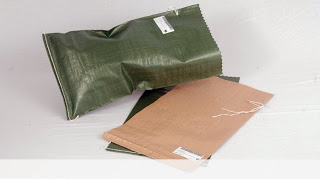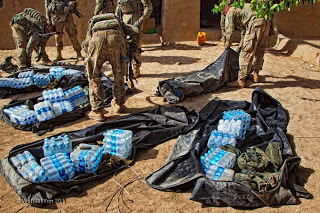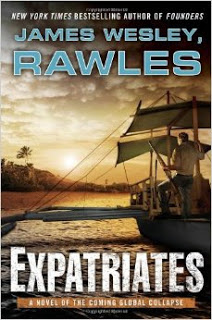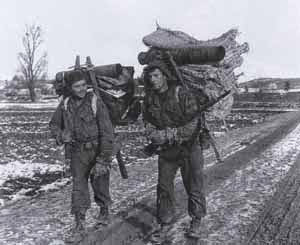Praxis: Improvised Resupply By "Speedball."
The 'definitive glossary of modern US military slang' defines "Speedball" as: A body bag filled with supplies, usually ammunition and bottled water, dropped from a plane or helicopter to resupply soldiers far afield or in dire need.
Michael Yon describes the use of "Body Bags & Speedballs" in Afghanistan here.
Body bags as speedballs in Afghanistan.
Some folks have even designed specially drop-resistant bags for re-use as in Bulldog Equipment's – Speedball Bag. (Be sure and watch the short video where the ammo cans within the bag fail the long drop, but the bag does not.)
"Yeah, Vanderboegh," you might reply, "but WE don't have helicopters to resupply FROM, so what's the good of that to US?" Mind you, spending scarce dollars for such a piece of durable equipment would be a waste for a modern-day militiaman and would violate the speedball's charm -- which is the utility achieved by the very fact of its improvisation. In fact, the helicopter-borne body-bag speedball is merely an up-sizing of a very old infantryman's trick of improvised front-line resupply and it took John Wesley, Rawles' latest book to remind me of it. Behold, the common modern, rot-resistant sandbag:

Now, I've known about speedballs since I first absorbed veteran's stories told at my old man's Saturday night beer parties. The old man wasn't a vet. (He volunteered for both World War II and Korea but had been turned down as 4-F both times because he had suffered tetanus when he was a child and couldn't open his mouth wide enough to eat K-Rations -- and, yes, the Army actually had a standard for how far you had to be able to open your mouth.) But most of our neighbors were veterans of the Army or Marine Corps and it was from one of them that I heard the trick of using a sandbag as an improvised carry device.
I received in the PO Box the other day a review copy of Rawle's new book, Expatriates.
Like all of Rawles' books, it is filled with practical stuff -- gear descriptions and tactical tricks worth emulating. Here is Rawles' on speedballs. The setting is part of large ambush about to be sprung on a huge but undisciplined body of looters moving down a major highway next to a railroad embankment in central Florida:
Jake and Tomas shared a granola bar. As they did so, Tomas said, "I wish I had a helmet. That would double my life expectancy." After a beat, Tomas continued. "I've been thinking about something. You know how you were teasing me about carrying too much gear? well, one thing I've got in ALICE pack is a couple of sandbags. When I was in the Marines, our battalion commander always insisted that each of us carry four sandbags. At first we hated that, since we were always humping around a ton of stuff, like we each also had to carry two mortar rounds. But those sandbags later turned out to be useful for a lot of things other than ballistic protection. For instance, we used them for packing speedballs."
"What's a speedball?" Jake asked.
Tomas explained. "That's something that both Army and Marines use, depending on the tactical situation or terrain, when part of a unit is under fire, and the rest of the guys are masked by terrain. When the guys up front, who are pinned down and doing most of the shooting, call back for a speedball, you take a sandbag and put in a couple of bandoleers of 5.56, a belt box of 7.62, and a few water bottles, and carry it forward."
Jake looked incredulous. "You think we're going to get pinned down?"
"No, no, no. I'm just explaining why amomgst all my other gear I have three sandbags in the bottom of my rucksack. I say we fill them with soil here, and then we can lay them on the railroad track to give each of us a few more vertical inches of frontal protection. Hey, we've got the time, and it might give us a slight advantage."
The man with the Mini-14 next to them chmed in. "I'll take that third bag, if you don't mind."
"Sure, no prob."
The three men spent the next fifteen minutes quietly scraping sandy soil into the olive drab nylon bags using Marichal's canteen cup as an impromptu shovel. Once the bags were filled, they used some black plastic cable ties from Jake's pack to close each of them.
Rawles description of sandbag speedballs prompted me to search my memory for when I first heard about sandbags as improvised carry-alls. I think it may have been in a humorous story from Lee Thackeray, an Army veteran of Korea, who mentioned it in a tale about shepherding some reluctant Korean porters (called "Kat--ooh--sahs" for KATUSA -- "Korean Augmentation to the United States Army") with a resupply of ammunition, water and rations up the backside of a hill position under Chinese assault. Of course the sandbags were then made of burlap, but with twine ties they were closed shut and then lashed with rope onto indigenous A-frames, USGI pack boards or suspended from poles.
GIs carrying gear on traditional Korean A-Frames, December 1950, on retreat from Pyongyang.
The main thing was that, improvised or not, sandbags were available, handy and useful. If any other veterans reading this post would like to chime in with their own stories of speedballs, please feel free to do so.




4 comments:
Mike,
It's pronounced "kah-two-sahs".
Other then that, you're spot on, as usual.
B Woodman
III-per
It should be known -
"Speedball" already is in use as slang.
It's the combination of cocaine and heroine, cooked and then shot up via needle to vein.
It's a killer, not a life saver, though it is something of acre supply.
Broke my heart to see this as I buried my best friend over speedballs.
To me, and maybe I'm just alone in this, it occurs to me that this is just another way to infect our understanding by using slang ambiguously - sometimes with intent to bring harm by using a slang also found elsewhere.
But hey, maybe this use can defeat the understanding of a speedball being deadly.
That carrying a few sandbags thing is a good idea. "Uline" has the cheapest prices I've seen for them, averaging about 36 cents a piece in bundles of 100. Folded up they take up virtually no room in a pack a Rawle's scenario shows a definite usefulness.
People who build "earthbag" homes use feedbags which are sold in bulk really cheap. The bad news is that they are white, so won't work well in a situation where you want something camo.
Post a Comment